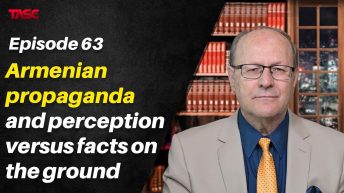In Episode 43, we have learned that Professor Justin McCarthy had discovered in the US National Archives in 1990, a survey of eastern Anatolia conducted in the summer of 1919 by two Americans, Captain Emory H. Niles, and Mr. Arthur E. Sutherland Jr. Their account is one of the first descriptions of this region by outside observers after World War I. However, the document was missing the authors’ field notes, which the authors emphasized should be read in conjunction with their report. Some 20 years after that momentous discovery, Niles and Sutherland’s field notes have been found in the archives of the former American Board of Commissioners for Foreign Missions (ABCFM) in Istanbul, by another American historian, Brian Johnson. In Episode 44, I covered Johnson’s research work titled “Americans Investigating Anatolia: The 1919 Field Notes of Emory Niles and Arthur Sutherland,” published in peer reviewed The Journal of Turkish Studies, 34, II, 2010, 129-147. A pdf version is available on the internet. Between 14 July and 12 August 1919, Emory Niles and Arthur Sutherland, employees of the aid organization called The American Committee for Relief in the Near East, or the Near East Relief for short, traveled from Mardin to Trabzon, by way of Bitlis, Van, and Erzurum, visiting 23 cities, to determine their relief needs of the locals and how the Near East Relief could fulfill them. They were the first Americans to enter this area of Turkey after the war. Their report was mixed in among various papers related to the Major General James G. Harbord Commission—a survey expedition sent by President Wilson to Anatolia and the South Caucasus in September 1919 to investigate the feasibility for an American mandate over the region and the establishment of an Armenian state that would include most of eastern Turkey. Harbord traveled from Mardin to Tiflis, but took a different route than Miles & Sutherland, which is why Harbord relied in his report on Niles & Sutherland observations of Bitlis and Van. Harbord, however, distorted their findings to make them better fit Harbord Report’s tone and tenor. The ABCFM, a Protestant mission agency founded in 1810 to spread Protestant teachings worldwide, first appeared in Anatolia in 1820. By the 1850s, the ABCFM had already built an extensive network of schools and hospitals. The outbreak of the WWI interrupted missionary activities abruptly, although the US did not enter the WWI for almost three years. What is worse was the fact that the Armenians, in whom the missionaries invested most, deserted from the Ottoman army when the country was fighting for its survival and joined the invading enemy armies of the Tsarist Russia. Armenian insurgents killed another 80,000 Muslims during the Van rebellion in April-May of 1915, ethnically cleansing the entire area of its Muslims. The two numbers alone add up to 200,000 Muslim dead, representing about 2 % of the Ottoman Muslims. The measures undertaken by the Ottoman government in the spring of 1915 to expel the rebellious Armenians from the war zones, inter-communal fighting, and banditry led to the flight or death of many Armenian inhabitants. The American Committee for Armenian and Syrian Relief established by missionaries to assist Armenians, painted in its pro-Armenian reports the entire Muslim populace as marginal, misguided, and tyrannical. The US politicians and media accepted such reports uncritically. Even Niles and Sutherland report was shunned, buried uncaringly in other reports, hid from the public eye, and forgotten. During WWI, American missionaries were principal informants about events in Anatolia and their bigoted accounts remain a prime source for the history of this era even today, and still accepted at face value uncritically. Niles and Sutherland recorded human and material losses, interviewed local officials and inhabitants. They estimated the need for food supplies and other support. They saw some devastated villages as well as half destroyed ones with their few inhabitants in miserable condition. Roads and bridges were in poor condition. World War I had, indeed, taken a heavy toll on all the peoples of eastern Anatolia, not just Armenians as popularly believed in America. According to the estimates of Niles & Sutherland, 4,000 Muslims were left from the 30,000 who inhabited Bitlis prior to 1914, the rest having been killed or fled and about 90 percent of the town had been destroyed. The Muslim quarter was in total ruin, with an estimated 6,500 homes lost. Mosques, shops, public buildings, and bridges had also been wrecked. The same general conditions were evident throughout the region, especially in territory that had been under Russian and Armenian control. In the province of Van, 150,000 Muslims remained from pre-war populations of 301,000. The majority Muslim community had suffered greater loss.
Myths and Realities




Add comment